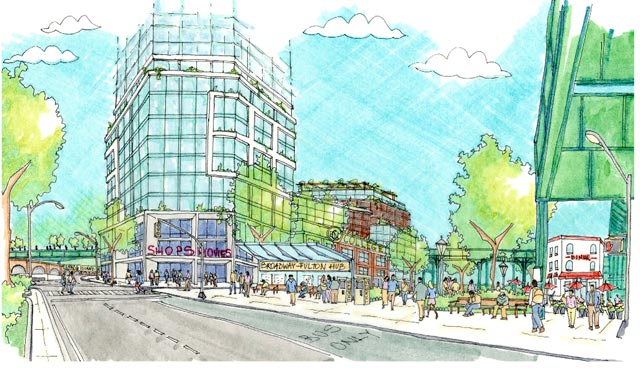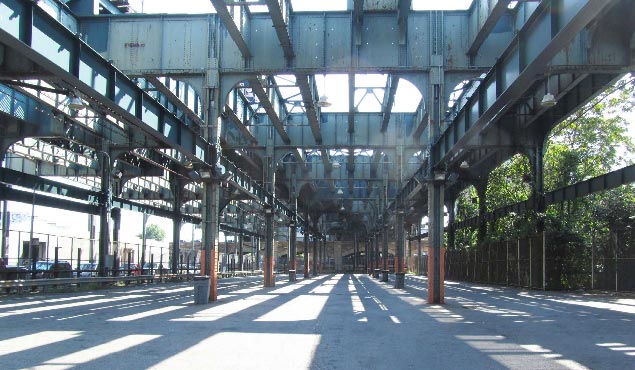When it comes to parts of New York City primed for new development, Brooklyn’s East New York may not be the first to come to mind. But this transit-rich and under-utilized node is first in line as the de Blasio administration embarks on 15 neighborhood re-zonings, part of the mayor’s plan to build and preserve 200,000 units of affordable housing over the next ten years.
A complete plan for East New York is at least several months away, but a draft report from the Department of City Planning gives clues about what to expect: no towering apartments, but mid-rise housing along Atlantic and Pitkin Avenue and “regional scale development” near Broadway Junction.
Atlantic Avenue has the biggest potential for new residential development. Today, Atlantic is primarily commercial with parking lots, auto repair shops, and car-washes scattered amongst 3-4 story buildings dating from the 1880s and 1890s.
New housing on Atlantic isn’t allowed under current zoning—only commercial or industrial development—something that de Blasio will certainly change. The vision is a mixed-use corridor with mid-rise buildings flanking a redesigned Atlantic Avenue.
The plan also calls for the redevelopment of Pitkin Avenue to the south and Fulton Street to the north, both of which would also host new residential development. The planning study suggests changing zoning from low-density to medium-density; residential side streets between Fulton, Atlantic, and Pitkin would most likely be preserved as low-rise districts, though with three nearby subway lines, these streets could certainly handle higher densities.
The vision laid out for Broadway Junction is more ambitious, calling for “regional scale” development similar to Brooklyn’s Atlantic Terminal. The plan hinges on attracting an anchor, with offices, retail, movie theaters, or a college as potential uses. A rendering shows a single commercial tower amongst lower-scale buildings, nestled next to a public plaza.
Because there aren’t any parcels of an appropriate size for development on this scale, the plan suggests that some streets may be de-mapped, as “site assemblage will be necessary.”
In order for this vision to work, significant investments will be needed to improve the streetscape and the public realm. Broadway Junction is well-served by transit, but the elevated tracks of the L train and LIRR, along with the Atlantic Avenue viaduct, make the area difficult to navigate and unwelcoming.
Atlantic Avenue has several large, vacant, and underutilized sites that could catalyze additional transformational developments. One example — Arlington Village — is a complex of half-occupied low-rise apartments on 300,000 square feet of land. In the industrial area to the west, the 100,000 square foot Long Island Rail Road substation has the potential for adaptive reuse.
An abandoned elevated rail spur could be transformed into a new pedestrian overpass, and a truly ambitious plan would include a High-Line style park. Space below the tracks could potentially be transformed into part of the public sphere, hosting markets and festivals and acting as a community gathering area.
Planning Commissioner Carl Weisbrod has suggested that East New York will be a model for future city re-zonings. If this is the case, one has to wonder if the city is being ambitious enough. Atlantic Avenue could certainly accommodate high-rise development; it’s flanked by two subway lines and is 120 feet wide.
If the city wants to make a legitimate difference in the affordability crisis, plans for the outer boroughs should be more ambitious than the preliminary proposal. East New York can and should support high-density development, but it will take political courage for the neighborhood to live up to its full potential.
For any questions, comments, or feedback, email [email protected]
Subscribe to YIMBY’s daily e-mail
Follow YIMBYgram for real-time photo updates
Like YIMBY on Facebook
Follow YIMBY’s Twitter for the latest in YIMBYnews



